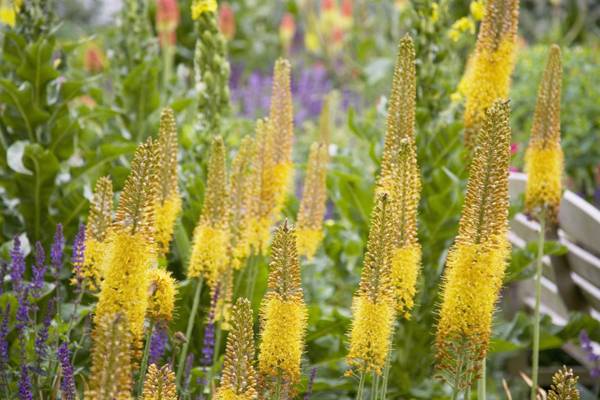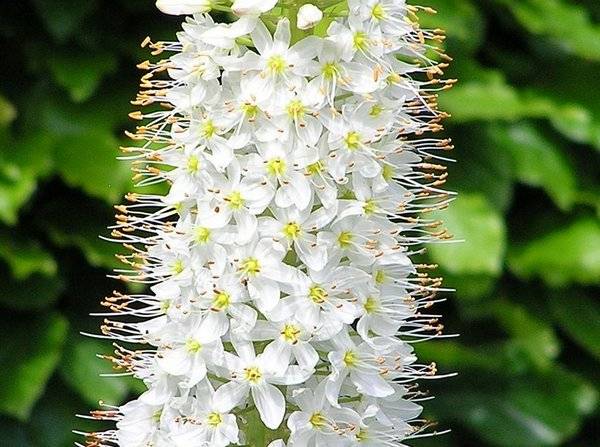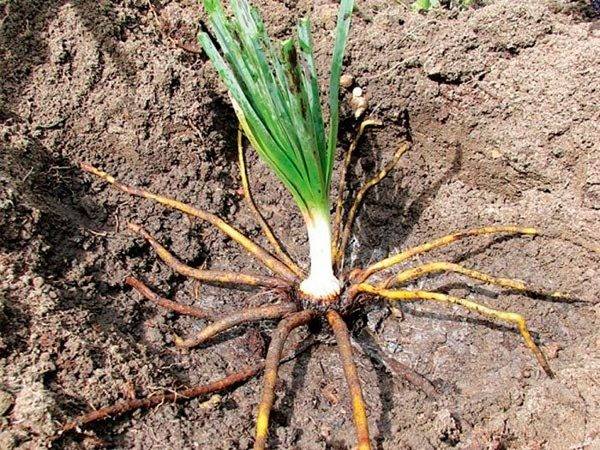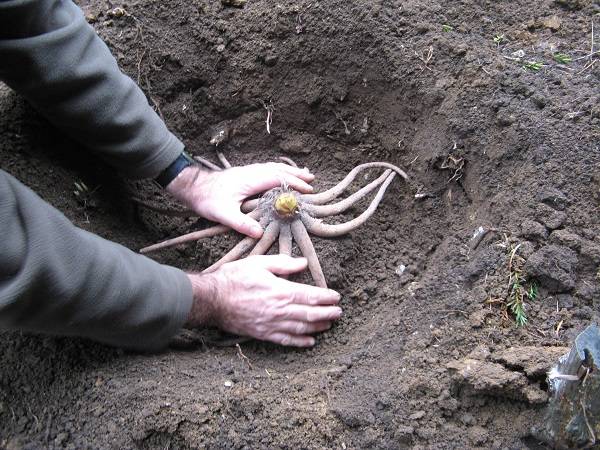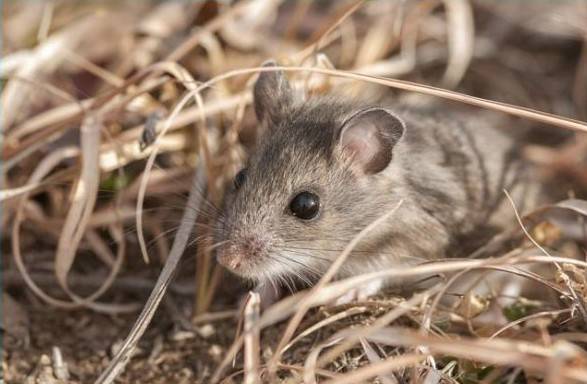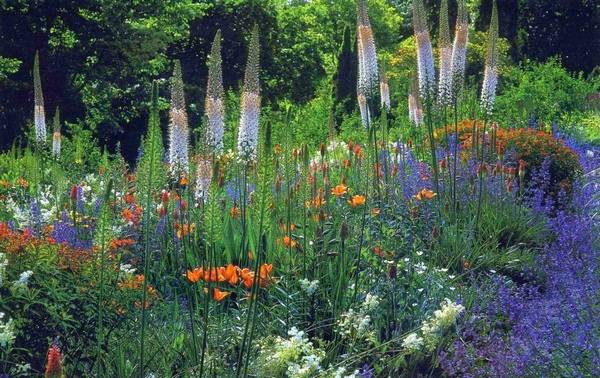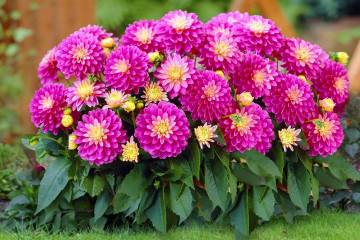Eremurus - planting and care in the open field
Content:
The eremurus flower is considered to be one of the vibrant and exotic varieties that adorn gardens and personal plots in the middle zone of the country. Plant care is not difficult, although it has a number of features.
Description of eremurus
Eremurus flowers are representatives of the Asphodelic family of the Ksantorreev family.
The plant has a powerful and strong stem, growing from 1 to 2.5 m, the root system resembles an octopus, it is distinguished by annual renewal with the death of the lower section and the formation of a young upper one.
Foliage of various shapes, it all depends on the variety, it can be narrow and wide. Collected in spectacular sockets. The buds are arranged on the stems in a star-like spiral. The petals are colored in shades of white, pink, cream, orange, yellowish, burgundy and red. Fluffy stamens often have a contrasting tone.
Why doesn't eremurus bloom after planting? From germination of sprouts to the appearance of the first buds, it can take up to 5 years. Not all seeds germinate in the first year, some should only be expected in the second season.
Types and varieties of eremurus
The perennial eremurus has almost 50 varieties of varieties and hybrid plants. Common varietal crops include:
- eremurus Albert with rare smooth and straight leaves, up to 1.3 m high. It has a loose arrangement of flowers, stamens and perianths are painted in a reddish tone, clearly visible among the snow-white petals. Inflorescences 0.6 m long and up to 12 cm in diameter;
- alpine eremurus with inclined stems, yellowish-greenish buds and dark orange anthers. The height of the bush is 1.5 m;
- Eremurus Himalaicus is distinguished by wide and bright green leaves, snow-white petals. It grows up to 2.5 m and is considered one of the most decorative varieties;
- Olga's eremurus grows up to 1.5 m, has narrow dark green foliage. White or pink buds are located in brushes up to 15 cm in diameter;
- Eremurus deceiving, or Bunge, grows to 1.75 m. It has narrow lanceolate foliage with a slight bluish semitone. The buds have yellowish-golden colors, they are localized in long inflorescences (up to 60 cm), each has 6 to 7 hundred flowers.
The well-known mixed varieties, bred by the breeder M. Foster from the subspecies of Olga and Bunge, include:
- Moneymaker with an orange-yellowish color;
- Isobel with orange-pinkish petals;
- Rosalind with bright pink buds;
- White Beauty with snow-white flowers.
This subgroup includes the Eremurus Cleopatra, which is considered one of the most attractive subspecies with brightly flaming orange buds and dense inflorescences. It reaches a size of 1.25 m. Eremurus Pinocchio has similar orange shades of petals.
Growing eremurus from seeds
Reproduction of eremurus from seed is one of the popular methods.
Sowing
Planting of seed material is carried out in autumn days, for the procedure, containers with a height of 20 cm are taken. The seeds are injected into the soil one by one by 1-2 cm, after the procedure, the boxes are transferred to the room until the first spring month. Storage is carried out at a temperature of 15 ° C.
The soil mixture is periodically moistened, since the seedlings react negatively to drying out. The first shoots are formed in March, some of the seeds will sprout in the next season. The germination time of seed is from one month to a calendar year.
Seedling care
If Eremurus is chosen, planting and caring for young seedlings will not require a change in conditions. The container is transferred to a warm room, protected from direct sunlight. The soil is often irrigated and monitored to prevent water accumulation. With warming, the seedlings are sent to fresh air with enough light, without direct sunlight. Watering is carried out regularly.
By the first week in September, the upper part begins to die off, the seedlings are sent to a dark place, watering is stopped. With the onset of spring heat, the sprouts will hatch again, they continue to look after them according to the standard algorithm.
Planting eremurus in open ground
The description indicates that planting an eremurus and leaving in the open field begins with finding a suitable place. The land must be completely drained, with preference given to rocky and sandy types. The composition of the soil for the culture is not important, but it grows better with an alkaline or neutral reaction. The area should be completely open with free access to light. Long stems of the plant are not afraid of winds and drafts.
When to plant eremurus
Transfer works are carried out in the first autumn weeks in September. Seedlings of the Eremurus plant are planted 1-3 years after sowing, the exact dates depend on climatic conditions. In Siberia, three-year-old plants with fully formed bottoms or parts of the rhizome from an adult bush are transplanted into open ground.
How to plant
Landing operations are carried out according to the algorithm:
- Before the procedure, the site is checked and, if there is insufficient moisture permeability, it is drained: a pebble, crushed stone or gravel cushion is created.
- The fertile layer should reach 50 cm in depth, it is enriched with humus or compost.
- Dig holes 30 cm deep, carefully place seedlings in them (along with an earthen lump).
- The distance between the bushes is observed: for large ones 0.6 m, for compact ones - 0.4 m.
- The root system is carefully straightened, the voids are covered with earth and compacted.
- Abundant watering is carried out.
Caring for eremurus in the garden
It is not difficult to take care of the shrub if certain requirements are exactly met:
- water regularly;
- fertilize the soil four times a year: in autumn (superphosphate at 40 g per m²), in spring (with a complex mineral composition of 60 g per m² or compost at 6 kg), the remaining two dressings are carried out on May days and before the formation of buds;
- weed and loosen the sand with utmost care so as not to damage the tubers.
How to water an eremurus
The perennial eremurus flower has its own preferences for moistening the earth:
- for the normal growth of the green part and buds, it requires high-quality watering;
- in case of drought and lack of rain, up to 2 times a week, the soil should be soaked 20 cm deep;
- with regular rains and after the end of flowering, irrigation is not carried out.
Reproduction of eremurus
It is advisable to cultivate an eremurus by the seed method. The seedlings will be adapted to the specific area in the garden. The disadvantages of the method, flower growers include a long wait for the plants to mature, therefore they prefer to carry out reproduction by dividing the mother bush.
The procedure is prescribed at the end of August after the complete withering away of the aboveground part, but before the culture leaves the dormant stage. The rhizome is dug up, parts are cut according to the number of growth buds. Places of cuts are sprinkled with activated carbon powder, then the cuttings are sent back into the soil. On spring days, each of them will have their own escape. By the end of summer, when the green part dies off, they are seated.
Diseases and pests
Diseases and parasites attack the bushes during damp and cold summers. The culture is often overwhelmed by:
- chlorosis;
- rust;
- viral diseases.
The plant is liked by snails, slugs, various rodents. The latter prefer to eat the underground part of the bush.
Blooming care
Before budding, plants are watered with nitrogenous or complex mineral fertilizer. You can buy them at any hypermarket or garden store. During flowering, the amount of watering is reduced, dried foliage and flower stalks are removed.
Eremurus after flowering
With the end of the summer season, the green part of the plant begins to die off. The process lasts from July 16 to September 1. At this time, the seed material, hidden in large spherical capsules, ripens. They are harvested or cut along with the peduncles.
How and when to collect seeds
The collected seeds (unripe) are dried in a room with good ventilation and a stable temperature regime. Ripe achenes (with cracks) are carefully cut and transferred to a dark and dry place before planting.
Preparing for winter
In early September, the tubers of the culture are dug up and dried in a warm utility room. After digging the soil and introducing fertilizers, the plants are returned to their original place at the end of September.
The procedure is not performed in warm and dry weather. A period without water supply to shrubs is necessary for the formation of flower buds, the number of buds in the next season depends on their number.
If it is impossible to dig up the tubers, then they make a shelter made of polyethylene, designed to protect from rain. Before the arrival of the first frost, it is necessary to mulch with compost or spruce branches to a height of 15 cm. This condition is suitable for areas with little snow. It is necessary to open the mulch (by raking it off the bushes) with the arrival of spring heat.
In warm and Siberian regions, where the snow cover is abundant (up to m), the shrubs calmly survive the most severe frosts. The only condition is that planting should take place on shallow hills, otherwise the roots from melt water can rot.
The use of eremurus in landscape design
The flower is used to add color to:
- flower beds;
- alpine slide;
- fences;
- lawns.
Cultivation of narrow-leaved eremurus is an easy task even for novice florists. The correct approach to watering and fertilization, autumn drying of tubers will help to grow this beautiful and unusual flower on the site.
